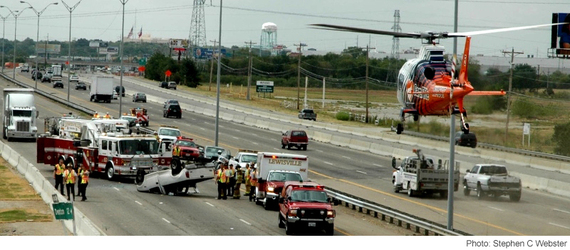
Lung Cancer and automobile accidents are two of the leading causes of avoidable deaths in North America. In response, all levels of governments have introduced legislation, fines and public education programs designed to minimize risk and save lives.
Anyone over the age of 30 remembers a time when restaurants and airplanes were filled with cigarette smoke. But starting in the 1980s, regulations to reduce second-hand smoke exposure were slowly introduced eventually banning smoking in bars, hospitals, airports, workplaces, etc.
To increase road safety we have speed traps, photo radar, traffic calming measures, breathalyzers, stronger penalties for street racing, etc. More recently, the focus has shifted to reducing driver distraction. After all, most accidents are not caused by alcohol or speeding, but by distracted drivers. The US National Highway Traffic Safety Administration states that even a two second distraction "significantly increases individual crash risk." Every year, governments across North America are bringing in new legislation and increased fines related to driver distractions.
There is no way to measure the precise impact of these initiatives, but there is little doubt that they have collectively saved thousand of lives. Public acceptance and support of these measures is nearly universal. At this point, it would be laughable to suggest that we re-introduce smoking in restaurants, or that we should allow people to text while they drive.
But there is one exception, one glaring anomaly that contradicts all other measures and efforts that have been made to save lives on our roads. That anomaly is roadside billboards. And in particular, digital billboards.
The outdoor advertising industry has one singular goal: to get your attention. For a hundred years we've had billboards scattered across our cities shouting out their messages about new cars, jeans, fast food and the latest television shows. But billboards only work if you notice them. So, increasingly, they are getting bigger and brighter in an effort to distract a larger audience. The newest innovation is digital billboards which display a new advertisement every ten seconds -- flashing thousands of times each day.
The human eye is hard-wired to look at bright, moving or flashing objects. It's an evolutionary feature that protects all animals from potential threats. When something moves quickly, your eyes automatically look towards it.
There are two sets of data related to digital signage and road safety. One is driver distraction and the other is collisions. The first category gives us very clear conclusions. Almost every study that's been done shows a direct causal relationship between digital signage and driver distraction. This is no surprise, since the purpose of these signs is to distract drivers! When it comes to collision data, however, we get inconsistent results. Some studies show a significant increase in collisions while others show little or no change at all. Experts blame this inconsistency on the fact that the collision data itself is often inaccurate or incomplete due to lack of proper reporting, and because so many other external variables are involved.
Lobbyists for the billboard industry have taken advantage of this inconclusive data, for collisions, and twisted it into an argument that digital signage is therefore safe for drivers. This is a terrible distortion of the truth, and a distortion that puts human lives at risk.
If we know that flashing digital billboards are guaranteed to increase distraction, and we know that driver distraction is the number one cause of traffic fatalities... then why would we even consider placing commercial digital billboards on highways?
The precautionary principle argues that we have a social responsibility to protect the public from exposure to harm when scientific evidence has found a plausible risk. This alone should lead every jurisdiction to implement an immediate ban on outdoor digital advertising.
Let's not make the same mistakes we did about smoking. The first suggestion that cancer was related to smoking was in 1912, followed seventeen years later by the first statistical evidence of a lung cancer-tobacco link. The first Surgeon General report stating the health risks of second-hand smoke appeared in 1972, but due to industry lobbying it took more than twenty years before smoking was fully banned in bars, airplanes and workplaces.
These days, we laugh at how absurd it was to allow smoking in restaurants, decades after we knew about the risks. And I have no doubt that one day, twenty years from now, we'll look back at this time and laugh at the absurdity of allowing bright digital billboards to be installed along highways and near urban traffic flow, designed explicitly with the sole purpose of intentionally distracting drivers.
New proposals are being submitted by the billboard industry every month, for increased digital signage on North American highways. And community groups are fighting back.
Today's politicians need to decide what side of history they want to be on. Do they want to help enable the growing corporate denialism of the outdoor advertising industry? Or do they want to be remembered as the ones who stood up to protect public spaces and save lives?
